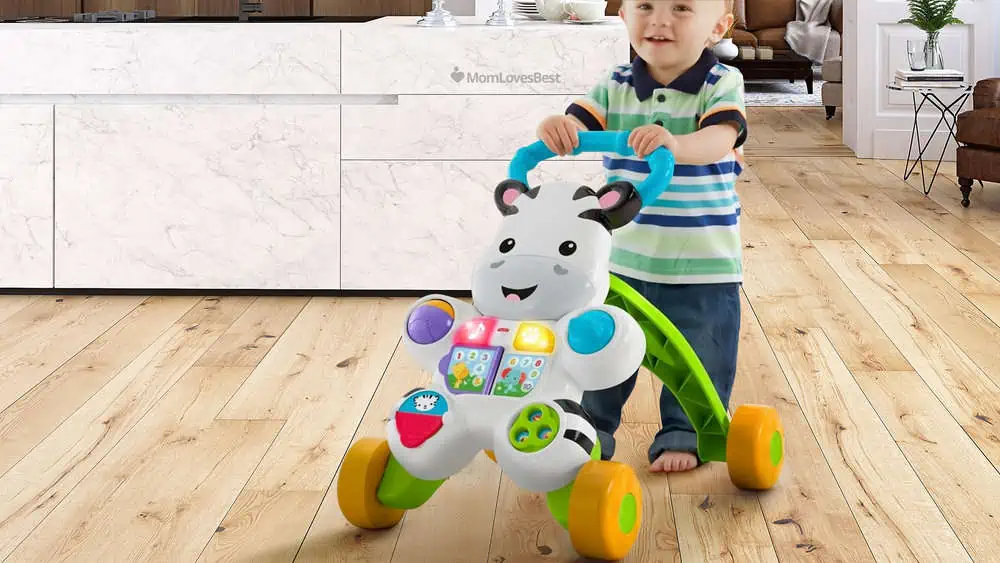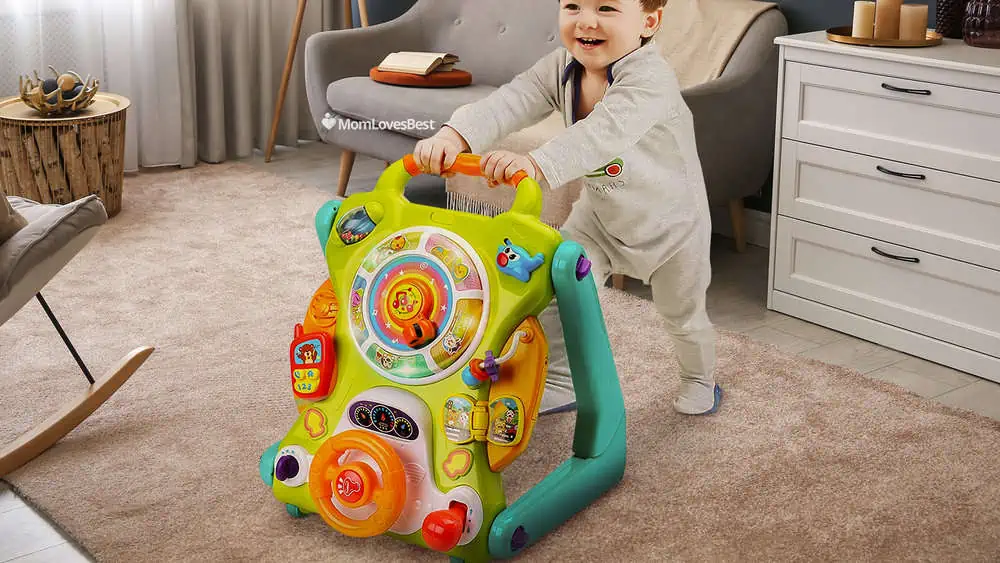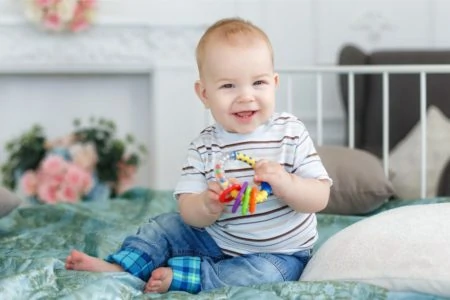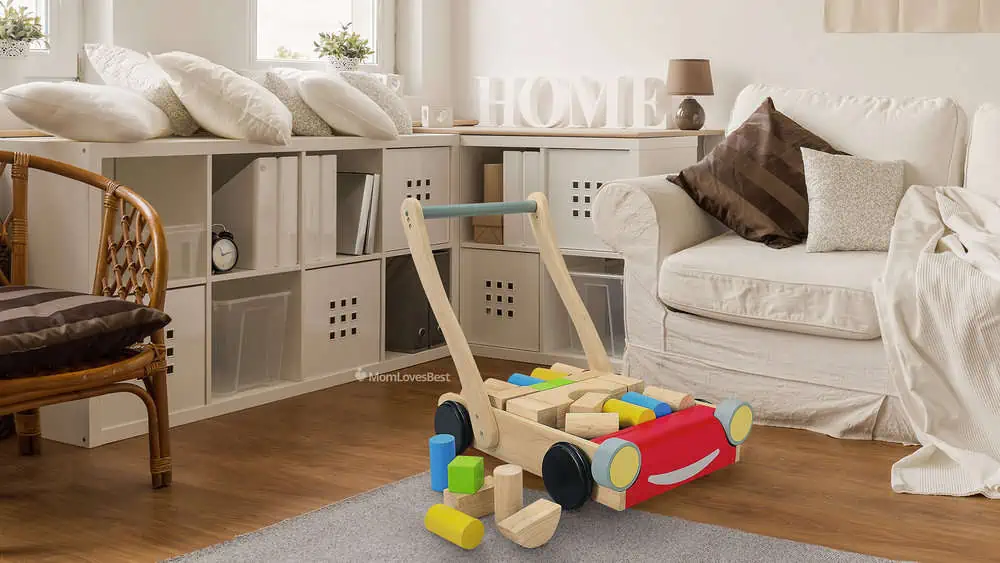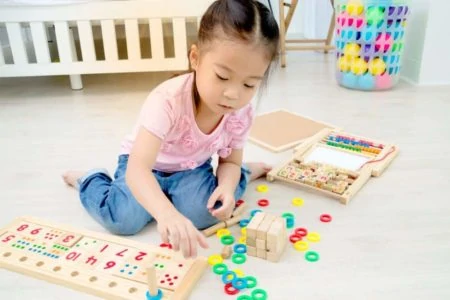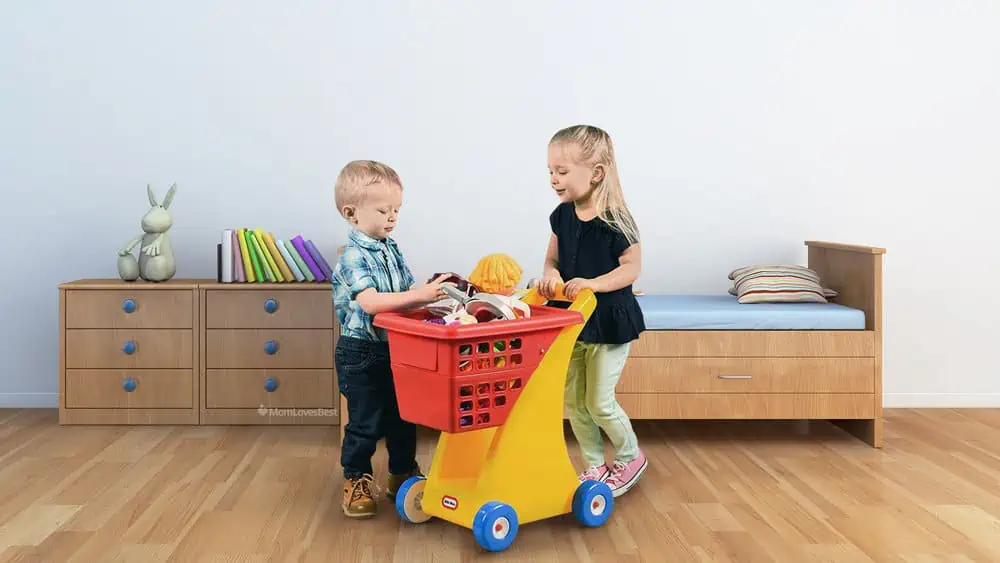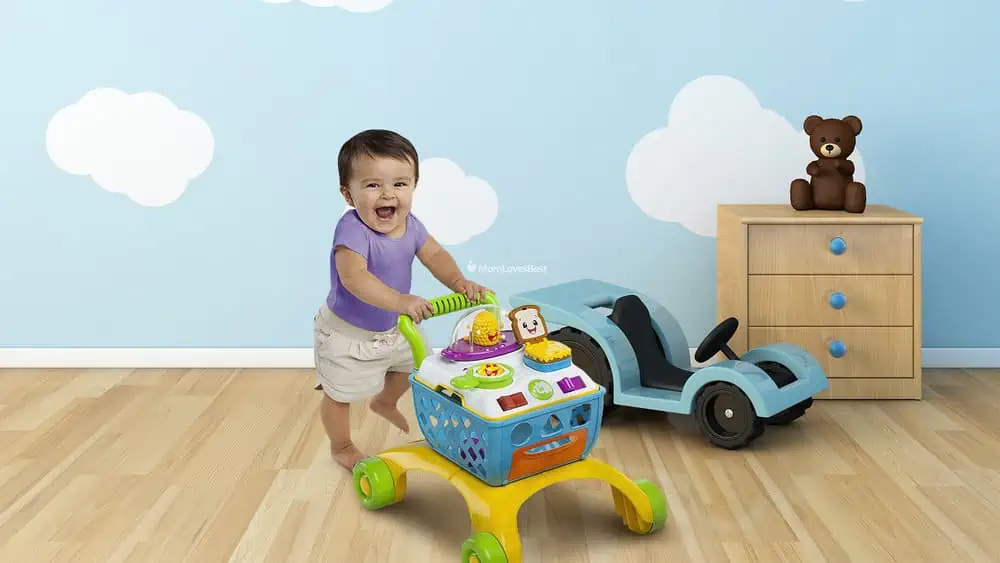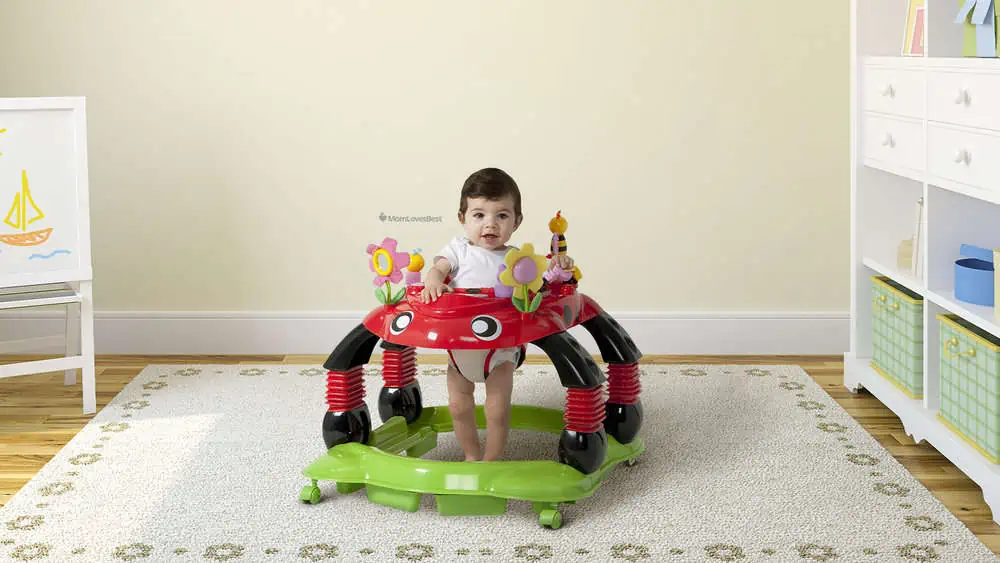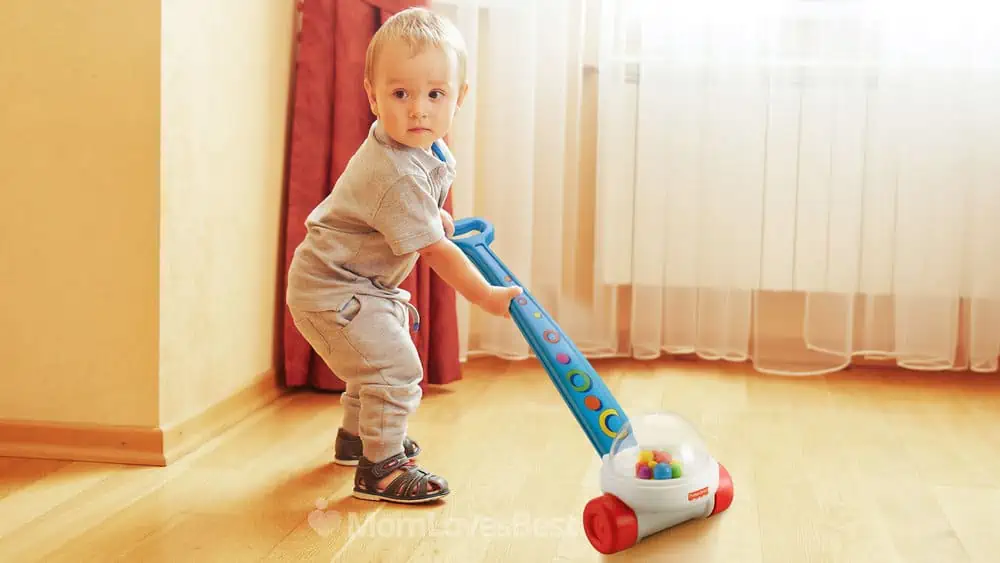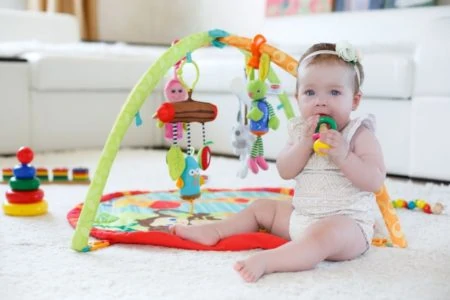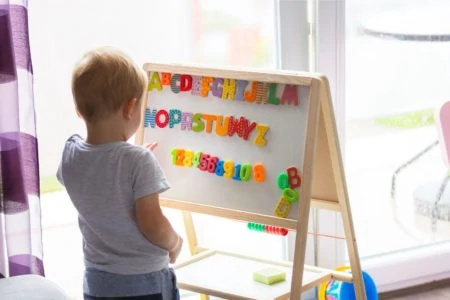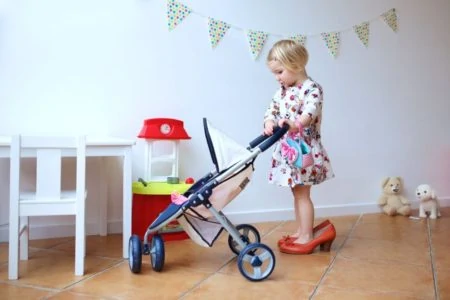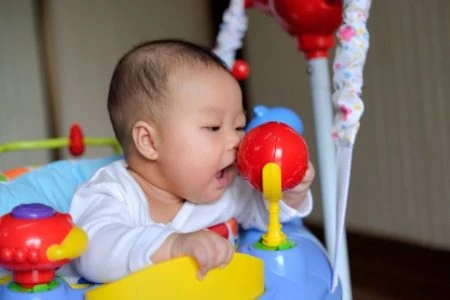Watching your baby take those first wobbly steps is a major milestone. Push toys and baby walkers bridge the gap between crawling and walking, helping your little one build the strength and balance they need to move independently. Instead of cruising along the furniture, a sturdy push toy gives them the confidence to explore the open floor.
There are countless options available, from wooden wagons to interactive activity centers. We researched and tested the best push toys on the market to help you find the perfect match for your baby’s developmental stage.
- Removable play panel
- Over 70 sing-along songs
- Enhances role-play fun
- Furniture-friendly bumper
- Resistance feature for beginners
- Award-winning push wagon
- Made from all-natural organic wood
- 24 colored and natural blocks
- Adjustable handle height and stiffness
- Eco-friendly design
- Dual function as toddler table
- Easy to maneuver
- Easy-rolling wheels
- Durable construction
- Provides plenty of space
- 4-in-1 shop 'n cook walker
- Removable cook top
- 1-year manufacturer's warranty
- Grows with your baby
- Encourages balance & motor skills
- Interactive learning
Why Push Toys Matter
Push toys do more than just entertain your child. They actively support physical development by improving balance, core strength, and coordination. These toys give babies the stability they need to test their limits without holding onto your hand.
You can introduce sturdy push toys once your baby starts pulling up to stand. They will likely teeter behind the handle as they find their footing. Be prepared for a few tumbles. A cushioned cloth diaper helps soften the landing when they plop down on their bottom.
Guide your baby’s hands to the push-along bar. Practice builds confidence. Before long, they will scoot around the house on their own.
Many push toys mimic real-world items like shopping carts, lawn mowers, or vacuums. Toddlers love to imitate parents. These toys fuel their imagination and stimulate fantasy play.
Manufacturers often include educational elements too. You will find counting games, songs, shape sorters, and building blocks integrated into the design.
Select the Right Age Range
Push toys must match your baby’s developmental stage. A toy that isn’t age-appropriate leads to frustration. If a walker is too heavy or fast, your baby might get discouraged.
The progression moves from standing to cruising, then to walking. Consider starting with a push toy that converts to a ride-on. Your child can scoot with their legs initially, then graduate to pushing the toy as their legs get stronger.
Always stay close by to offer a reassuring cuddle if they fall.
Around 15 months, your toddler should be strong enough to push a sturdy toy with wheels. By 18 months, they can handle lighter toys like brooms or vacuums. By age 2, your toddler will likely master pushing and pulling. This is when you need to be extra vigilant, as they will move fast.
Factors to Keep in Mind
Safety and usability are key factors when shopping. Keep these specific features in mind before you buy:
- Check the Height: The handle should sit at a comfortable level for your child. If it is too high or too low, it affects their balance.
- Test the Sturdiness: A weighted base prevents the toy from tipping over when your baby pulls up on the handle.
- Inspect the Wheels: Rubber-lined wheels provide traction and protect hard floors. Plastic wheels slide faster and work better on carpet.
- Look for Speed Control: Adjustable tension knobs or brakes are essential for beginners. They keep the walker from rolling away too quickly.
Product Reviews
Here are the top push toys to get your toddler moving safely.
VTech Sit-to-Stand
Interactive Fun
This unit is a classic for a reason. It serves children from 9 months up to 3 years. The key feature is the removable activity panel. You can detach it for floor play before your baby is even standing.
The panel includes a shape sorter, piano keys, a telephone, and plenty of lights. It offers 70 different songs and sounds. Fortunately, it includes a volume control switch for when you need a break from the noise.
When your baby is ready to walk, re-attach the activity center to the frame. The plastic wheels have rubber strips for traction. You can also adjust the rear wheel tension to slow the walker down for beginners, which is a massive help on hardwood floors.
Radio Flyer Classic Walker Wagon
Classic Design
This wagon offers superior stability for wobblers. The “resist-push” feature creates a clicking sound and prevents the wagon from rolling too fast. This builds confidence for babies who are just finding their feet.
The furniture-friendly bumper is a great addition for protecting your walls and baseboards. The handle stays in an upright position, so toddlers don’t have to bend down to reach it. It is suitable for ages 1 to 4 years.
One thing to note is that the wooden stake sides are removable. If your child likes climbing, you might want to store those stakes away until they are older. The deep wagon bed is perfect for hauling toys during cleanup time.
Fisher-Price Learn with Me Zebra
Walking and Educational Fun
This zebra is an affordable, lightweight option for getting started. You can use it as a sit-and-play station for babies as young as 6 months. The activity panel features turnable pages, light-up buttons, and dials to twist.
When your baby pulls up, the four-wheel base provides decent stability. The handle is easy for small hands to grasp. It plays educational songs about the alphabet and numbers as your child moves. Note that the wheels are hard plastic, so it moves quickly on smooth floors. It works best on carpet or textured rugs where there is natural friction.
iPlay, iLearn Baby Walker
Three-in-One Fun
This versatile toy converts between an activity table, a walker, and a drawing board. It offers excellent value for the long term. The activity center keeps sitting babies busy with a steering wheel, phone, and rattle beads.
The triangular walker frame is very stable. You can fill the water tank in the back legs to add weight, which prevents the walker from tipping over. This is a huge safety plus. When walking time is over, convert it to a magnetic drawing board to fuel their inner artist. It is suitable for ages 6 months and up.
Plan Toy Baby Walker
Traditional Wooden Baby Walker
If you prefer sustainable materials, this walker is made from recycled organic rubberwood. It features a clean, minimalist design suitable for ages 10 months to 3 years. The handle height is adjustable, which is rare for wooden walkers.
The standout feature is the friction knob on the rear wheels. You can tighten it to create resistance for new walkers and loosen it as they gain speed. It comes with 24 colored blocks, turning the walker into a mobile building station. It is sturdy, heavy, and less likely to tip than plastic alternatives.
Little Balance Box 2-in-1
Walker with a Difference
This is a walker without wheels. It looks like a small table and uses spring-loaded feet to glide across the floor. This design provides maximum stability for babies who rely heavily on the toy for balance. It won’t roll away unexpectedly.
The wide top surface allows babies to transition easily from kneeling to standing. It moves slowly on both carpet and hard floors. When your child isn’t pushing it, the clear top acts as a perfect snack or play table. It is pricier than standard walkers, but the safety and stability are top-notch.
Little Tikes Shopping Cart
Time to Go Shopping
Toddlers love to mimic their parents. This cart lets them run their own errands around the living room. It is best suited for children aged 2 and up who are already walking confidently.
The deep basket holds plenty of play food, and the fold-down seat fits a favorite doll or teddy bear nicely. The wheels are durable plastic, suitable for indoor or outdoor use. The base is wide and stable, but because it is lightweight, a child can tip it if they lean their full weight on the handle.
Bright Starts Giggling Gourmet
For the Budding Curtis Stone or Rachel Ray
This 4-in-1 toy combines a cooktop, activity table, and shopping cart. At 6 months, your baby can play with the removable cooktop on the floor. It features popping sandwiches, sizzling sounds, and rollers.
Once your baby stands, lock the wheels to create a stationary activity table. When they are ready to move, unlock the wheels to transform it into a push walker. The wide wheelbase provides good support. However, the plastic wheels slide easily on hardwood, so it works best on carpet or play mats during the early walking stages.
Fisher-Price Laugh & Learn Stride-to-Ride Puppy
Learning and Leaning Puppy
This puppy offers three modes: sit, push, and ride. Babies can feed blocks into the puppy’s mouth and watch them tumble out below. This teaches cause and effect while keeping them entertained.
The seat lifts up to become a handle for walking. Later, you can put the seat down for a ride-on toy. It talks and sings as your child moves. Be aware that the wheels do not lock, so the toy can move if a baby leans on it to pull themselves up. Supervision is necessary for beginners.
Delta Children Walker
Adjustable Height
This is a seated walker rather than a standing push toy, but it serves a similar developmental goal. It allows pre-walkers to zoom around while supported by the seat. It works for children up to 30 pounds.
The 3-position height adjustment lets the walker grow with your child. The removable toy tray features lights, sounds, and textured flowers for sensory play. If you need a safe place for your baby to explore while you cook or clean nearby, this is a solid choice. Just ensure you block off stairways.
Fisher-Price Laugh & Learn Walker
Push and Pull for Older Toddlers
This red wagon features a long handle for pulling, making it ideal for toddlers aged 6 months to 3 years. It focuses on Smart Stages learning, with over 75 songs and phrases that advance as your child grows.
The handle is stiff and stays upright, so younger babies can use it for support. However, pulling requires a different skill set than pushing. This is a great transition toy once your baby has mastered their first few steps. It is durable and easy to wipe clean.
Hape Wonder Walker
Gears and Knobs for Fine Motor Skills
Hape delivers a visually stunning wooden walker for ages 12 months to 3 years. The design includes colorful gears, sliding balls, and knobs directly on the frame. It keeps fine motor skills sharp during rest breaks.
The rubber-trimmed wheels are quiet and gentle on floors. The base is wide and heavy enough to support a child pulling themselves up. The cargo shelf allows toddlers to transport their teddy bears easily. It requires some assembly, but the quality wood construction lasts for years.
Kolcraft Tiny Steps Baby Walker
Grows with Baby
This clever hybrid converts from a seated walker to a walk-behind push toy. It accommodates babies from 15 pounds up to 26 pounds. You can start them in the seat to build leg strength, then remove the seat to encourage independent walking.
It folds flat for easy storage, which is a lifesaver in small apartments. The play tray includes a bead bar and spinning ball to develop hand-eye coordination. Note that the wheels do not have a resistance setting, so it moves freely.
Fisher-Price Busy Activity Walker
Space Saving Push Toy
This walker folds down into a floor activity center. Babies can sit and spin the gears, flip doors, or bat the roller ball. When you unfold it, the frame locks into a sturdy triangle shape for walking.
It is lightweight and easy to carry or store. The wheels are wide for balance, but like many plastic walkers, it is fast on hardwood. It is an excellent budget-friendly choice that covers the basics without taking up your entire living room.
Little Tikes Gas 'n Go Mower
For the Future Landscaper
This is the ultimate role-play toy for toddlers aged 18 months and up. It requires no batteries. The sounds are purely mechanical, so you never have to worry about power running out.
As your child pushes, the beads in the clear dome pop, mimicking an engine. They can pull the starter cord, click the key, and slide the throttle. It comes with a removable gas can for “refueling.” It is lightweight, so it is better for children who are already walking steadily rather than those needing heavy support.
Kiddery Toys Wooden Learning Walker
Tumbling for Tots
This premium wooden walker focuses on multifunctionality. It acts as a storage chest and an activity center. The side panels and front feature a xylophone, number flaps, and a sliding maze.
The rubber-lined wheels provide smooth movement and good grip. The sturdy wooden handle gives a solid grip for toddlers. It encourages social play since multiple kids can interact with the different sides simultaneously.
Labebe Orange Owl Push Toy
Take the Toys for a Walk
The Labebe walker features a charming owl design and a large cargo space. It is perfect for 1 to 3-year-olds who love transporting their belongings. The wheels have a rubber ring to prevent floor scratches and control speed.
The weight of the wood makes this very tip-resistant. If your baby loses balance, they can sit in the cart or simply hold the handle for support. It is easy to assemble with just a screwdriver.
Hape Lilly Musical Walking Bird
Good First Wooden Push Toy
This push-along toy works differently than a walker. It features a stick handle and a bird that “sings” as it rolls. It is designed for babies around 12 months who are already taking steps and want a companion.
The wheels are rimmed with rubber to protect your floors. The chirping sound encourages your child to keep moving to hear the song. It is excellent for refining balance and coordination one-handed.
Cossy Wooden Baby Walker
What Does the Fox Say?
This walker features a cute fox design and high-quality Dutch wood construction. The water-based paints are non-toxic and safe for teething babies. The TPR wheels increase friction, ensuring the walker doesn’t slide out from under your child.
It comes with building blocks that fit into the cargo area. This adds a puzzle element to the toy, as children learn to fit the shapes back into the tray. It is a fantastic mix of physical and mental stimulation.
Fisher-Price Corn Popper
Retro Push Toy
This iconic toy has encouraged walkers for generations. As your toddler pushes it, the colorful balls inside the dome pop loudly. It teaches cause and effect instantly: faster walking equals more popping.
It is best for confident walkers because it requires one-handed operation. It is durable, inexpensive, and works on almost any surface. Just be prepared for the noise, kids love it, but it is definitely loud.
Melissa & Doug Alligator Push Toy
See You Later Alligator
This wooden walker creates a rhythmic “clacking” sound as the three alligators open and close their mouths. It is incredibly satisfying for toddlers to watch and hear. It includes three spinning bug beads on the handle for extra engagement.
The construction is solid hardwood with non-toxic paint. The wheels feature rubber strips for grip. However, the speed is not adjustable, so supervise your child closely on slick floors. It is best for children aged 12 months and up.



